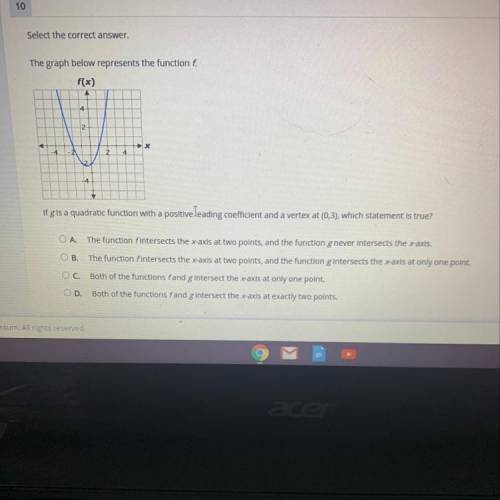
Mathematics, 12.08.2020 05:01 fr12345
The graph below represents the function f.
f(x)
if g is a quadratic function with a positive leading coefficient and a vertex at (0,3), which statement is true?
А.
The function fintersects the x-axis at two points, and the function g never intersects the x-axis.
B
The function fintersects the x-axis at two points, and the function g intersects the x-axis at only one point.
c.
Both of the functions fand g intersect the x-axis at only one point.
D
Both of the functions fand g intersect the x-axis at exactly two points.


Answers: 3


Other questions on the subject: Mathematics

Mathematics, 21.06.2019 17:20, maliyahsanmiguel
Given: hf || jk; hg ? jg prove: fhg ? kjg to prove that the triangles are congruent by asa, which statement and reason could be used as part of the proof? fgh ? kgj because vertical angles are congruent. jkg ? hfg because vertical angles are congruent. fhg ? jkg because right angles are congruent. hfg ? kjg because alternate interior angles are congruent.
Answers: 1

Mathematics, 21.06.2019 22:50, 7obadiah
He graph of f(x) = |x| is stretched by a factor of 0.3 and translated down 4 units. which statement about the domain and range of each function is correct? the range of the transformed function and the parent function are both all real numbers greater than or equal to 4. the domain of the transformed function is all real numbers and is, therefore, different from that of the parent function. the range of the transformed function is all real numbers greater than or equal to 0 and is, therefore, different from that of the parent function. the domain of the transformed function and the parent function are both all real numbers.
Answers: 3

Mathematics, 21.06.2019 23:00, keishadawson
Could someone me with this question i’ve been stuck on it for 20 minutes
Answers: 1

Mathematics, 22.06.2019 00:00, mattiemattoos
One of the complementary angles is 4 degrees mor than the other. find the angles (recall that complementary angles are angles whose sum is 90 degrees.) which of the following can not be used to solve the problem if x represents one of the angles? a. 2x-4=90 b. 2x+4=90 c. x+4=90
Answers: 1
You know the right answer?
The graph below represents the function f.
f(x)
if g is a quadratic function with a pos...
if g is a quadratic function with a pos...
Questions in other subjects:


Social Studies, 10.06.2021 22:50

Mathematics, 10.06.2021 22:50


Mathematics, 10.06.2021 22:50


Mathematics, 10.06.2021 22:50

Geography, 10.06.2021 22:50


Mathematics, 10.06.2021 22:50



